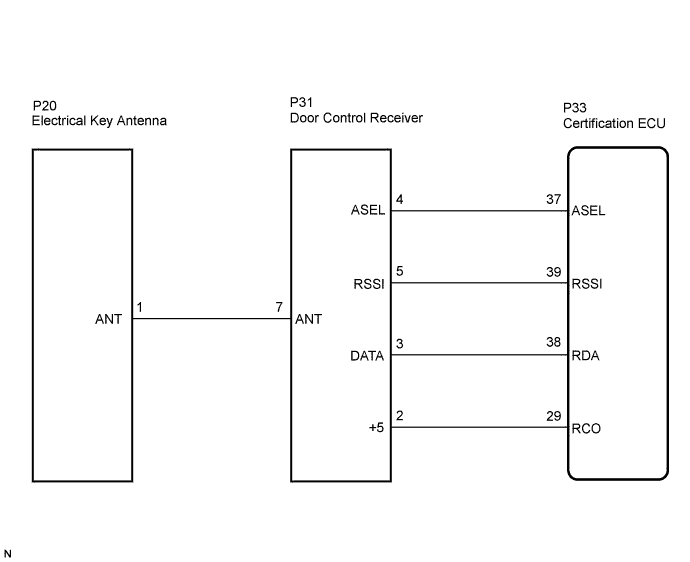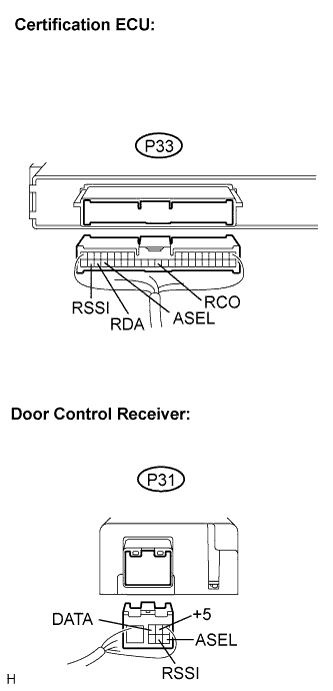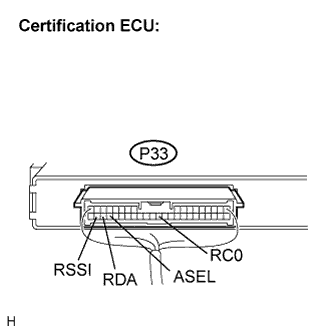Dtc B1242 Wireless Door Lock Tuner Circuit Malfunction
DESCRIPTION
WIRING DIAGRAM
INSPECTION PROCEDURE
CHECK HARNESS AND CONNECTOR (CERTIFICATION ECU - DOOR CONTROL RECEIVER)
CHECK HARNESS AND CONNECTOR (DOOR CONTROL RECEIVER - ELECTRICAL KEY ANTENNA)
CHECK AND REPLACE DOOR CONTROL RECEIVER (RECONFIRM DTC)
CHECK AND REPLACE ELECTRICAL KEY ANTENNA (RECONFIRM DTC)
INSPECT CERTIFICATION ECU
DTC B1242 Wireless Door Lock Tuner Circuit Malfunction |
DESCRIPTION
- The electrical key antenna and the door control receiver are used as antennas for the entry and wireless door lock functions of the entry and start system.
- The certification ECU decodes the requested entry and start system operation by identifying a key code based on electric waves received via the electrical key antenna and the door control receiver. The ECU then sends a command, according to the requested operation, to each ECU. (e.g. If door lock operation is requested, the ECU sends a door lock command to the main body ECU RH.)
DTC No.
| DTC Detection Condition
| Trouble Area
|
B1242
| If the certification ECU detects that terminal RDA or RSSI is short-circuited, this DTC is stored.
| - Electrical Key Antenna
- Door Control Receiver
- Wire harness
- Certification ECU
|
WIRING DIAGRAM
INSPECTION PROCEDURE
| 1.CHECK HARNESS AND CONNECTOR (CERTIFICATION ECU - DOOR CONTROL RECEIVER) |
Disconnect the P33 ECU connector.
Disconnect the P31 receiver connector.
Measure the resistance according to the value(s) in the table below.
- Standard resistance:
Tester Connection (Symbols)
| Condition
| Specified Condition
|
P33-37 (ASEL) - P31-4 (ASEL)
| Always
| Below 1 Ω
|
P33-39 (RSSI) - P31-5 (RSSI)
| Always
| Below 1 Ω
|
P33-38 (RDA) - P31-3 (DATA)
| Always
| Below 1 Ω
|
P33-29 (RCO) - P31-2 (+5)
| Always
| Below 1 Ω
|
P33-37 (ASEL) - Body ground
| Always
| 10 kΩ or higher
|
P33-39 (RSSI) - Body ground
| Always
| 10 kΩ or higher
|
P33-38 (RDA) - Body ground
| Always
| 10 kΩ or higher
|
P33-29 (RCO) - Body ground
| Always
| 10 kΩ or higher
|
| | REPAIR OR REPLACE HARNESS OR CONNECTOR |
|
|
| 2.CHECK HARNESS AND CONNECTOR (DOOR CONTROL RECEIVER - ELECTRICAL KEY ANTENNA) |
Disconnect the P20 antenna connector.
Measure the resistance according to the value(s) in the table below.
- HINT:
- Perform the measurement with the P31 receiver connector disconnected.
- Standard resistance:
Tester Connection
(Symbols)
| Condition
| Specified Condition
|
P31-7 (ANT) - P20-1 (ANT)
| Always
| Below 1 Ω
|
P31-7 (ANT) - Body ground
| Always
| 10 kΩ or higher
|
| | REPAIR OR REPLACE HARNESS OR CONNECTOR |
|
|
| 3.CHECK AND REPLACE DOOR CONTROL RECEIVER (RECONFIRM DTC) |
Replace the receiver.
Clear the DTC and repeat the procedure to re-check for DTCs (Click here).
- OK:
- DTC is not output.
| | END (RECEIVER IS DEFECTIVE) |
|
|
| 4.CHECK AND REPLACE ELECTRICAL KEY ANTENNA (RECONFIRM DTC) |
Replace the antenna.
Clear the DTC and repeat the procedure to re-check for DTCs (Click here).
- OK:
- DTC is not output.
| | END (ANTENNA IS DEFECTIVE) |
|
|
| 5.INSPECT CERTIFICATION ECU |
Reconnect the P33 ECU connector.
Reconnect the P20 antenna connector.
Reconnect the P31 receiver connector.
Measure the voltage according to the value(s) in the table below.
- Standard voltage:
Tester Connection
(Symbols)
| Condition
| Specified Condition
|
P33-37 (ASEL) - Body ground
| Engine switch OFF, luggage compartment door OPEN
| Below 1 V
|
Engine switch OFF, luggage compartment door CLOSE
| 4.6 to 5.4 V
|
P33-39 (RSSI) - Body ground
| Engine switch OFF, all doors closed, the electrical key is not in the action area
| 10 to 14 V
|
Engine switch OFF, all doors closed, the electrical key in the action area
| Below 1 V
|
P33-38 (RDA) -Body ground
| Engine switch OFF, all doors closed and electrical key switch OFF
| 10 to 14 V
|
Engine switch OFF, all doors closed and electrical key switch ON
| Pulse generation
|
P33-29 (RCO) - Body ground
| Engine switch OFF, all doors closed and electrical key switch OFF
| Below 1 V
|
Engine switch OFF, all doors closed and electrical key switch ON
| 4.6 to 5.4 V
|
| | REPLACE CERTIFICATION ECU |
|
|
| OK |
|
|
|
| PROCEED TO NEXT CIRCUIT INSPECTION SHOWN IN PROBLEM SYMPTOMS TABLE |
|



